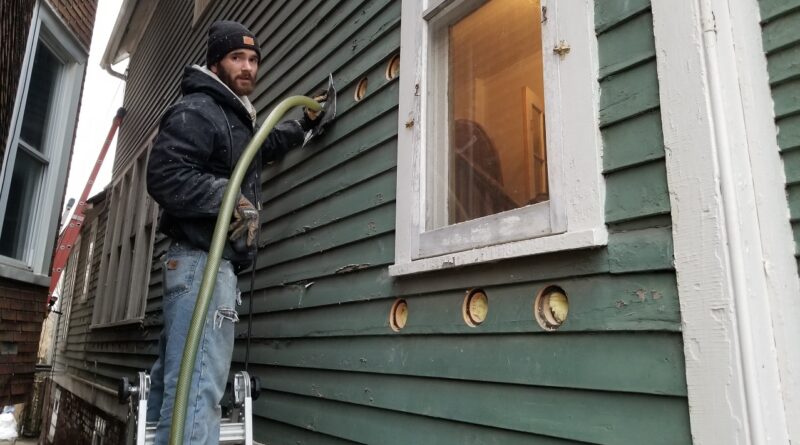Busting Insulation Myths with Ron Cowgill
Podcast: Play in new window | Download (Duration: 1:34:13 — 42.4MB)
Subscribe: Apple Podcasts | Spotify | Android | iHeartRadio | Podchaser | Email | TuneIn | RSS | More
(July 19, 2020) This is a story about busting insulation myths. And it’s a story about my home.
Skip to a specific segment in this podcast
8:03 Chad Rigsby, Ph.D. of Bartlett Tree Experts
47:15 Ron Cowgill from Mighty House Home Improvement Radio
1:25:23 Meteorologist Rick DiMaio
I live in a barn. Well, I used to live in a barn. And it wasn’t a real barn. It was, and is, my home. It’s just that Kathleen and I bought the 130-year-old frame structure in 2000 “as is.” At the time, we called it the last affordable home in Chicago. But we quickly learned what “as is” meant. It meant two ugly bathrooms. It meant fix the roof. It meant a basement that was prone to flooding, and still is. It meant a bunch of original windows. It meant almost no insulation. Not in the walls or the windows or even in the attic. And, during that first winter, it meant a gas bill of $600. For one month. Ouch.

If you figured that I immediately starting working on improving the efficiency of my home, you would be figuring wrong. I’m not a home improvement guy. Yes, we had the asbestos-laden vermiculite removed from the attic by guys in hazmat suits. Yes, I climbed into the attics (there are two, separated by a wall) and rolled out not quite enough fiberglass insulation bats. We even had a door blower test (more on that later) done to determine where the leaks were. They were everywhere. We were living in a barn in the middle of Chicago.
That started to change when I met Ron Cowgill. A lot of you know him as the host of Mighty House Home Improvement Radio. He is also the owner/operator of D/R Services Unlimited, Inc. in Glenview, Illinois. It is a full service remodeling firm that does kitchens, baths, repairs, custom builds and more. Here are just some of his credentials.
- Master Certified Remodeler (MCR) through NARI
- Certified Kitchen and Bath Remodeler (CKBR) through NARI
- Green Certified Professional (GCP) through NARI
- Universal Design Certified Professional (UDCP) through NARI
- Licensed electrical contractor (1998-Current)
- State of IL Licensed EV Charger Installer
- State of IL Licensed Solar Installer (Distributed Energy Installer)
When we met in 2008, we both had radio shows at Progresso Radio down the dial. I left that station in 2014 and eventually ended up at WCGO Radio in 2017. He joined me there that same year, though he left at the end of 2019. Now, Mighty House is strictly on the Intertubes, though it is currently in a hiatus. The problem? Ron and co-host Rich Cowgill (no relation. Really!) have been inundated with work at their respective businesses. We might be in the midst of a pandemic, but folks still want their homes fixed.
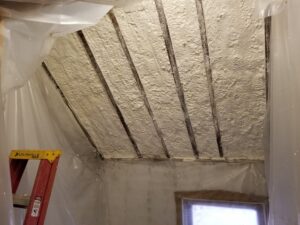 We formed a friendship and he started helping get the house in shape. We added more insulation to the attic. We foamed the basement ceiling to slow down the drafts coming up into the house. He replaced the sorry excuse for a basement door that was leaking like sieve. All well and good, but we were just nipping around the edges.
We formed a friendship and he started helping get the house in shape. We added more insulation to the attic. We foamed the basement ceiling to slow down the drafts coming up into the house. He replaced the sorry excuse for a basement door that was leaking like sieve. All well and good, but we were just nipping around the edges.
And then, a miracle happened. Kathleen and I found out about something called The 606 Bloomingdale Trail Neighborhood Home Improvement Program. It’s a two-year pilot, using $1 million from the city’s Affordable Housing Opportunity Fund to help keep neighborhood families in their homes. One of the sponsors was the alderman of our 26th Ward, Roberto Maldonado. Here’s how he explained the program in a newsletter.
“The market here is extremely hot since the 606 was built, and I think we need to slow it down so we can allow for economic diversity,” said Ald. Roberto Maldonado. The grants would encourage low- and middle-income homeowners to stay in their homes rather than “take the cash that Realtors and developers are throwing at them,” he said.
“Replacing the roof or porch makes the home less of a target for low-ball buyers who will tear them down,” explained Maldonado. The grants cover masonry repairs, porch and roof improvements, tuck-pointing, door and window repairs, and other exterior upgrades.
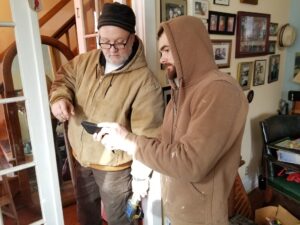
And insulation? Why not? After all, this is a story about busting insulation myths. Kathleen and I are definitely in the low to middle-income bracket. I’m in radio and she’s a freelance writer. If you think radio guys–especially those who talk about gardening and the environment–make a lot of money, I have some 606 real estate to sell you. So we applied for the $25,000 grant and, not too surprisingly, we qualified. However, we then had to go into a lottery. Well, I can no longer say that I never win anything, because our names were drawn.
If I may inject a political comment here, this is how government is supposed to work. It should be there to help citizens stay in their homes by creating programs that are fair and provide people with opportunities to make their lives better. Thank you, Alderman Maldonado. Thank you, City of Chicago and, yes, even former Mayor Rahm Emanuel.
But now we needed a contractor. I think you know where I went first. I told Ron about the project and he wanted in. But, we needed to get three bids, so we found two other contractors. Ron’s secret weapon was that he had an ulterior motive for doing the job. Here’s the story.
He has been itching to prove “the window guys” wrong for awhile. They’re the guys who advertise heavily on TV and tell you that the only way to improve the energy efficiency in your home is by purchasing their pricey windows. Ron saw it another way. Namely, that windows are only part of the problem, and likely not the most important part. He wanted to document that by using my home as the test case.
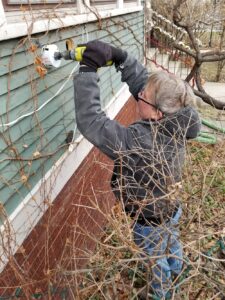
Fine with me. Get the bid in and let’s go. So that’s what we did. First, however, he wanted to know how badly our home was leaking air. So he brought in Joe Konopacki from Insight Property Services, Inc. to do a door blower test to measure the ACH, or Air Changes per Hour. Actually, we did THREE door blower tests. And, remember when I wrote about the door blower test that I had done on my own? That was in 2008, when, basically, the house was still a barn. So that first test was a kind of baseline from which we could analyze the three we did in about three months.
Then Ron’s excellent guys got to work. Ron and I had already insulated the attic, but there were gables that had no attic space. In those areas, the plaster ceiling was removed (remember, this is a 130-year-old house), foam was blow between the beams, and the ceiling was replaced. That was done by Richard Spiess of Innovative Insulation Solutions, Ltd.
Then the hard part–insulating the walls.
First, a little background. The folks at Neighborhood Housing Services administered the grant. They were great to work with, especially construction specialist Wallace Brown, who guided us every step of the way. However, they expected us to Tyvek the outside walls and cover it with vinyl siding. Kathleen and I love the look of our wood siding, and wanted to keep it. This is where Ron Cowgill’s genius kicked in.
 His idea was to drill 4-inch diameter holes into the siding and blow in loose cellulose insulation. I can’t even begin to list the hoops of fire that were awaiting Ron’s crew. (Did I mention that the house is 130 years old?) But they got it done. Then it was on to finding all of the places where air was escaping–including a hole in the wall under the stairs to the second floor. And then they discovered a passageway between the two floors that was another place for air to escape.
His idea was to drill 4-inch diameter holes into the siding and blow in loose cellulose insulation. I can’t even begin to list the hoops of fire that were awaiting Ron’s crew. (Did I mention that the house is 130 years old?) But they got it done. Then it was on to finding all of the places where air was escaping–including a hole in the wall under the stairs to the second floor. And then they discovered a passageway between the two floors that was another place for air to escape.
After that, it was time to replace 28 of the 29 windows in the house. Yes, that’s correct. Let’s not forget that Kathleen and I work from home. And we have a cat that we love dearly. Fortunately, she’s very tolerant of strangers, if not particularly of loud noises. The windows were from Lang Exterior. The work began in early December, was interrupted by the holidays, resumed in January and finished in the first couple of weeks of February…just before the COVID-19 pandemic hit.
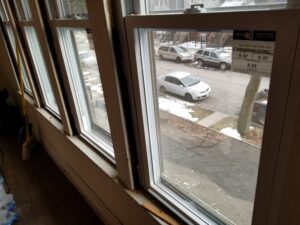 Look at it this way. We won the lottery to get our house fixed. Then we won the lottery again to have the work finished before being locked down, which is something that nobody predicted. We are so grateful to Ron Cowgill and D/R Services and Neighborhood Housing Services and Alderman Roberto Maldonado and the City of Chicago for making this happen. If you listen to my show regularly, you know that I have a lot of issues with the City. This time, they got it right.
Look at it this way. We won the lottery to get our house fixed. Then we won the lottery again to have the work finished before being locked down, which is something that nobody predicted. We are so grateful to Ron Cowgill and D/R Services and Neighborhood Housing Services and Alderman Roberto Maldonado and the City of Chicago for making this happen. If you listen to my show regularly, you know that I have a lot of issues with the City. This time, they got it right.
Since this is about busting insulation myths, we need some numbers. Here’s what Ron sent me about the door blower tests we did.
Blower Door Numbers – Air Changes per Hour (ACH)
1st blower door test no insulation (2008) ……………………….……………. 14 ACH
After attic and basement air sealing and insulation (before 2020) 10 ACH
After dense packed cellulose insulation…………………………………………. 7.1 ACH
After Window air sealing and replacement…………………………………….. 6.6 ACH
In Ron’s own words, “Point proven you should spend your money on air sealing and insulation in the attic, walls and basement BEFORE spending money on windows.”
It’s an honor to have my friend Ron Cowgill on today’s show to talk about this long, strange trip to making our house sustainable and livable.
Keeping your trees healthy in summer
It’s been a hotter summer than we’ve seen lately. Given that the Great Lakes are heating at an unprecedented rate this year and that the long-term outlook is not good, that should not be surprising. Which means that you should be looking out for your trees.
Once again, we welcome Bartlett Tree Experts to the show. In full disclosure, they are our main sponsor. And we couldn’t be prouder of that. But it is necessary for us, as a media outlet, to be as transparent as possible about the folks who support our programming.
Often, we have our Bartlett regulars like Skeet or Scott Jamieson on the show to talk about tree care. Today, we welcome Chad Rigsby, Ph.D., who is new to our program.
Chad Rigsby is a research scientist and technical support specialist with The Bartlett Tree Research Laboratories at The Morton Arboretum. Chad provides technical support for Bartlett Tree Experts Arborists throughout the country on many matters of arboriculture including pruning, soil, root, and pest management, and plant health care. Chad’s research reflects this diversity and covers many aspects of arboriculture, but his particular area of expertise is in tree stress biology and tree-pest interactions. Chad is particularly interested in understanding tree growth-defense trade-offs and how arborists can manage trees according to their growth-defense strategy, how belowground conditions impact aboveground interactions with pests, and developing best management practices that optimize cost and the health of young/newly planted trees.
Among the things we hope to discuss this morning are the repercussions of going from a cool, wet spring into a hot, dry summer. That includes how to keep younger/newly planted trees properly watered v. strategies for more mature and established trees.
We will also discuss some tree diseases, like needlecast, spruce and conifer problems in general, bur oak blight, and oak wilt. If it seems as though life is hard enough dealing with COVID-19 without jumping into tree diseases, we apologize. But that’s the real world. In fact, the University of Illinois Home, Yard & Garden Pest Newsletter just sent out a report on oak wilt.
And, speaking of Skeet, his recent newsletter included information about Is it oak wilt or oak anthracnose?
We welcome Chad Rigsby to The Mike Nowak Show with Peggy Malecki today.

